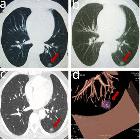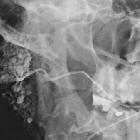pulmonale noduläre lymphoide Hyperplasie

Pulmonary nodular lymphoid hyperplasia (PNLH) is a type of benign lymphoproliferative disease that can affect the lung.
Epidemiology
It can present in any age group although the majority of cases present between 50 and 70 years of age .
Clinical presentation
Most cases are usually asymptomatic and found incidentally on imaging for an unrelated cause. Occasionally, there can be symptoms such as shortness of breath, cough and/or pleuritic chest pain.
Pathology
Most, if not all, such cases are favored tp represent extranodal marginal zone B-cell lymphomas masquerading as reactive lesions.
There is usually dense nodular infiltration of mature, polyclonal lymphocytes and plasma cells with multiple reactive germinal centers. These are sharply demarcated from surrounding parenchyma and with central areas of scarring. Foci of organizing pneumonia may be commonly seen in the periphery. There can also be mild, local lymphangitic spread of lymphocytes permeating into the perivascular interstitium.
Associations
Radiographic features
CT
Usually present as a solitary lesion. Described features on HRCT chest include :
- well-circumscribed nodular lesion: this can be a solitary pulmonary nodule or focal consolidation with an ~2 cm diameter
- coalescence of two or more nodules can rarely occur to form a discrete mass
- a very mild, focal lymphangitic pattern may be seen
History and etymology
It was initially described as pulmonary pseudolymphoma by S L Saltzstein in 1963 . The term pulmonary nodular lymphoid hyperplasia was suggested by Kradin and Mark .
Differential diagnosis
Imagin differential considerations include
- pulmonary lymphoma (especially MALT lymphoma affecting lung)
- nodules tend to be bilateral and multifocal and may show features such as pleural invasion
See also
- nodular lymphoid hyperplasia: general
- focal lymphoid hyperplasia of the lung
- pulmonary lymphoproliferative disease
Siehe auch:

 Assoziationen und Differentialdiagnosen zu pulmonale noduläre lymphoide Hyperplasie:
Assoziationen und Differentialdiagnosen zu pulmonale noduläre lymphoide Hyperplasie:



